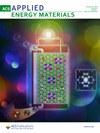电流体动力喷射打印银微柱上氧化锌纳米棒的制作与表征
IF 5.4
3区 材料科学
Q2 CHEMISTRY, PHYSICAL
引用次数: 0
摘要
将三维(3D)纳米结构集成到光电器件中,为提高性能和扩展功能提供了巨大的潜力。然而,由于缺乏有效的制造技术,三维纳米结构的发展一直受到制约。本研究介绍了一种三维纳米结构的两步制造方法,将氧化锌(ZnO)纳米棒(NRs)的生长结合到银(Ag)微柱(MPs)上。利用按需滴电-流体动力(DoD-EHD)打印技术制造的银微柱具有可控的长宽比,最大高度为 67 μm,直径为 2.60 μm,长宽比为 ∼26。柱子的数量和间距可通过软件和运动控制进行精确调整,这表明该方法在生产各种三维结构方面具有多功能性。随后,利用水热法在银微柱(MPs)表面生长了高密度氧化锌纳米棒(NRs),得到了平均长度为 5 μm、直径为 0.80 μm 的 NRs。对所得三维结构的表征表明,它们具有均匀的形态、高结晶度和优异的光学特性。Ag MPs 在 3.05 eV 和 ZnO NRs 在 3.40 eV 的双波段机制的确定证实了平面外三维金属-半导体异质结的成功形成,突显了它们在先进光电设备中的应用潜力。本文章由计算机程序翻译,如有差异,请以英文原文为准。

Fabrication and Characterization of Zinc Oxide Nanorods on Electrohydrodynamic Jet Printed Silver Micropillars
The integration of three-dimensional (3D) nanostructures into optoelectronic devices offers significant potential for performance enhancement and expanded functionality. However, the advancement of 3D nanostructures has been constrained by the absence of effective fabrication techniques. This study introduces a two-step fabrication method for 3D nanostructures, combining the growth of zinc oxide (ZnO) nanorods (NRs) on silver (Ag) micropillars (MPs). The Ag MPs, which exhibit a controlled aspect ratio, were fabricated using drop-on-demand electro-hydrodynamic (DoD-EHD) printing, achieving a maximum height of 67 μm, a diameter of 2.60 μm, and an aspect ratio of ∼26. The number and spacing of the pillars can be precisely adjusted via software and motion control, underscoring the method’s versatility in the production of diverse 3D structures. Subsequently, high-density ZnO nanorods (NRs) were grown on the surface of Ag micropillars (MPs) using the hydrothermal method, resulting in NRs with an average length of 5 μm and a diameter of 0.80 μm. Characterization of the resulting 3D structures demonstrated the uniform morphology, high crystallinity, and superior optical properties. The identification of a double-band regime at 3.05 eV for Ag MPs and that at 3.40 eV for ZnO NRs confirmed the successful formation of out-of-plane 3D metal-semiconductor heterojunctions, highlighting their potential for application in advanced optoelectronic devices.
求助全文
通过发布文献求助,成功后即可免费获取论文全文。
去求助
来源期刊

ACS Applied Energy Materials
Materials Science-Materials Chemistry
CiteScore
10.30
自引率
6.20%
发文量
1368
期刊介绍:
ACS Applied Energy Materials is an interdisciplinary journal publishing original research covering all aspects of materials, engineering, chemistry, physics and biology relevant to energy conversion and storage. The journal is devoted to reports of new and original experimental and theoretical research of an applied nature that integrate knowledge in the areas of materials, engineering, physics, bioscience, and chemistry into important energy applications.
 求助内容:
求助内容: 应助结果提醒方式:
应助结果提醒方式:


